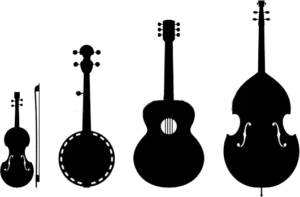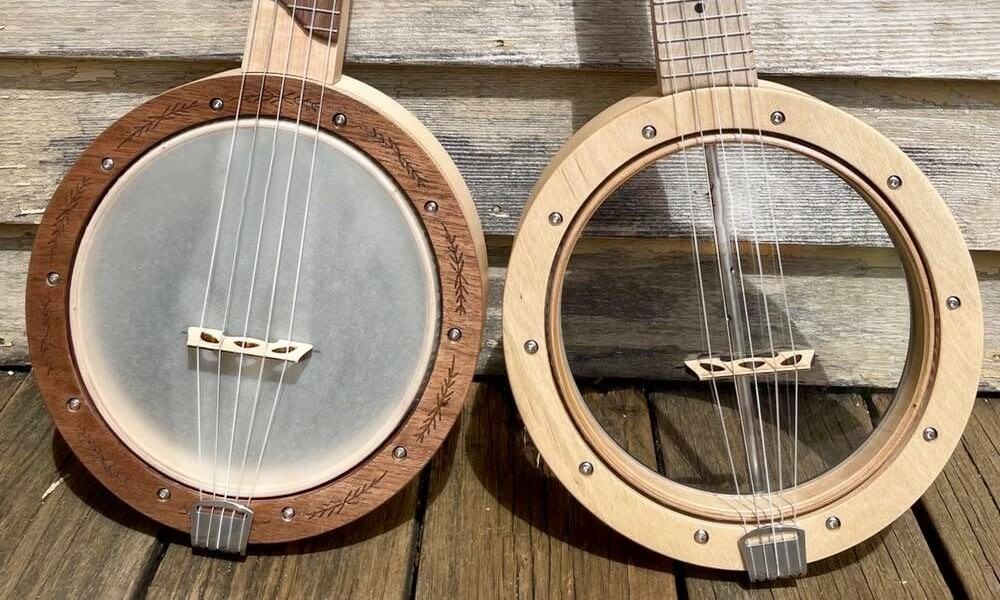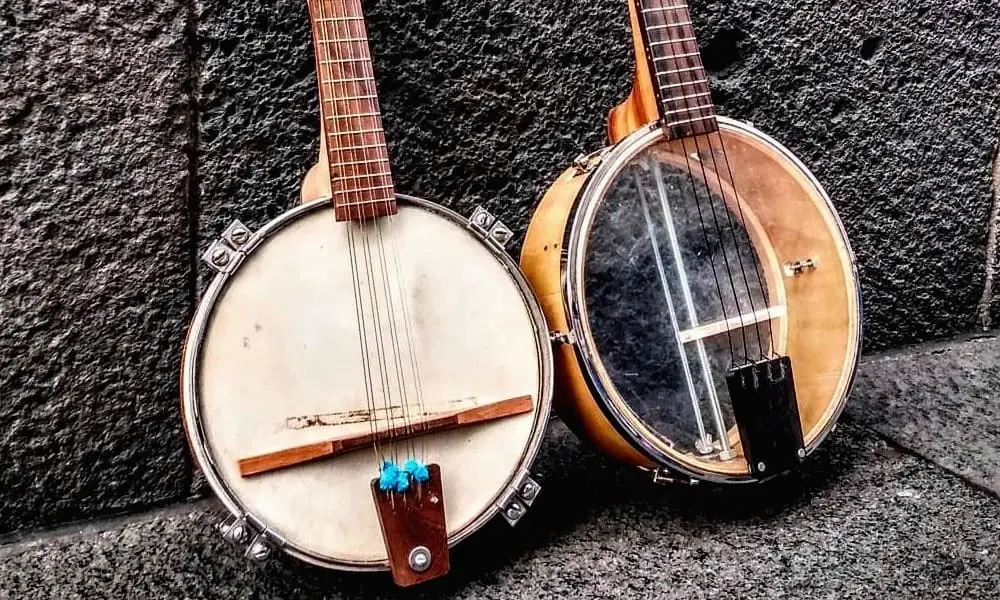When choosing the best tenor banjo, you need to multitask. It is important to consider not only the cost but other characteristics as well: the number of frets, weight, the presence or absence of a resonator, material, etc.
No doubt, the main criterion is that your instrument should be ideal for the style of music you play. In this article, I will briefly talk about the main advantages and disadvantages of popular tenor banjo models from different brands. I hope my reviews will help you select the best tenor.
5 Best Tenor Banjos Reviewed
From the variety of tenor banjos, I have selected some of the most outstanding options presented below. The list is not a ranking from the worst to the best, or vice versa. The instruments are located in random order.
1. Recording King Dirty Thirties: Best Tenor Banjo Overall
| Top Material Type: | Rosewood, Maple |
| Back Material Type: | Maple |
Recording King is a popular brand that makes great traditional banjos with a vintage vibe.
This instrument comes with top-notch features, and it has a lot of positive reviews on the Web.
This option has an open back, so the sound is not too loud but beautiful and soft. The front is made of rosewood and maple, and the back is completely maple. The tenor banjo has a narrow neck with 19 frets. It is very comfortable for small hands. The scale length is 23 inches. The instrument is lightweight (4.75 pounds). The design is reminiscent of the old 4-string banjos with its open back and lack of extra details. The open rim on this banjo provides an authentic tenor tone.
I have this option in my collection of musical instruments, and I can say that this banjo has a great sound, but it is not too loud and bright. The sound is traditional for the performance of folk music. It sounds especially distinct if tuned correctly. I am usually using the GDAE tuning.
- An affordable price
- It is very comfortable for small hands
- Lightweight
- An authentic soft sound
- It has no tonal ring
2. Deering Goodtime 17-Fret: Best Tenor for Design Quality
| Top Material Type: | Bottom frosted Mylar |
| Back Material Type: | Open Back |
| Number of Strings: | 4 |
The first instrument in my review is the open-back tenor from the American brand Deering, which makes excellent instruments for an affordable price. The front of the body is made of bottom frosted mylar. It has a high-quality rim made of 3-ply maple. This banjo weighs only 3.75 pounds so it has the lightest body of all items on the list. It is ideal for kids. The light-colored design and solid neck look like it’s a high-end collectible.
This instrument is the best choice for performers of Irish and Celtic music. The success of this option is that it has a simple but solid design, with no frills. The tuning is simple even for beginners, and such an instrument looks and sounds professional. Many musicians on different forums admire this model because they bought it for learning but later didn’t want to change it to a more expensive one.
My 13-year-old neighbor is also learning the banjo. I advised him to choose this model, and he liked it. The tool of such high quality is likely to serve him for many years. Since he loves Irish motives, this option is great for this sound. The kid has already learned a lot of compositions.
- Lightweight
- It looks and sounds professional
- The model has a simple tuning
- An excellent design quality
- It has no resonator
3. Deering Goodtime 19-Fret: Best Instrument for Bright Sound
| Top Material Type: | Bottom frosted Mylar |
| Back Material Type: | Maple |
| Number of Strings: | 4 |
The next one on my review is also a banjo from the well-known brand Deering.
The front of this 19-fret tenor is made of bottom frosted mylar, and the back is produced from maple. Excellent sound is achieved by a three-layer rim made of maple; a resonator is from the same type of wood. Due to the exquisite sound quality, the instrument could cost a little more. The best banjos in the world are made with 3 ply maple rims.
This option is chosen by musicians for its bright tone. It is lightweight (5.75 pounds) and offers excellent value for money. It makes it the best choice for beginners and experienced players alike. This model also looks stylish and neat at the same time. A high-quality maple rim will appeal even to experienced musicians.
I bought this model for myself, choosing it according to excellent reviews on the Internet. Although I planned to use this instrument for rehearsals, I take it to concerts as it has a solid appearance and is quite loud due to the quality maple rim.
- It is lightweight
- Entirely wooden
- It has a resonator
- A quality construction
- It is a good choice for beginners
- No hook to attach a strap to
4. Gold Tone 4-String: Best Tenor Banjo for Beginners
| Top Material Type: | Plastic |
| String Material Type: | Nickel |
| Number of Strings: | 4 |
The main tasks of this brand are the production of correctly fitted parts of a musical instrument and the perfect sound for an adequate price. This model is an open-back banjo. The front part is made of high-quality plastic, and the neck is mahogany.
This is a great option for those who are just starting to learn how to play the banjo, and it is suitable as the first musical instrument for a child. A beginner tenor banjo player should be happy to get this one. Many musicians take it on their travels.
The weight of this tenor is 6.38 pounds. The laconic design and small size will appeal to owners of small hands who are uncomfortable playing larger instruments. The composite rim looks stylish and modern. Although, this is unlikely to appeal to fans of “old design.”
The model from the Gold Tone brand has a soft sound and excellent value for money. My friend, who has this model in his collection, says that this banjo sounds especially great in Chicago tuning. He is also surprised that, for a relatively low price, he has acquired an instrument of such high quality and great sounding.
- The price is affordable
- It is ideal for beginners
- It has a soft tone
- A thin neck ensures convenience during the performance
- It has no resonator
5. Trinity River 4-String: The Top Tenor Price
| Back Material Type: | Nato |
| Number of Strings: | 4 |
Trinity River banjos are renowned for being perfect for beginners, have great sound, and are reasonably priced for their quality. The body of this musical instrument is made of nato; there is a resonator, which makes the sound much louder and more sonorous. This model has 18 brackets and 19 frets, and it weighs 8 pounds. The design balances authenticity with contemporary style: A glossy surface and white details look great.
Many musicians choose this model for playing on stage. Experienced players consider the GDAE Irish tuning as the best tuning for this banjo. However, this instrument is suitable not only for experienced musicians but also for beginners. Among all the pluses, there is a small minus: This option easily loses its tuning.
One of my banjo forum friends had a poor experience of buying the first tenor. After that, he chose this model. He is a beginner, but there were no problems with the tuning. A friend commented on the high sound quality of this model and how this instrument made the learning process fun and easy. He was very happy that he did not have to pay too much for such high quality.
- It has a resonator
- Excellent quality for stage performance
- It is well-suited for learning
- It easily loses its tuning

Tenor Banjo Buyer’s Guide
You might want to know more useful information about the musical instrument you want to buy. It is necessary to choose the item wisely but, at the same time, not to forget about personal preferences. Any instrument for a musician is like a piece of their soul. That’s why it’s important to choose the ideal one for you and your style of music. This is an especially difficult task for beginners. Analyzing the pros and cons will not seem such a boring routine if you understand that you will become the owner of a dream instrument in the end.
What is a tenor banjo?
A tenor banjo is considered the best 4-string banjo. This model traditionally has a short neck with 17 or 19 frets. The history of this musical instrument name has different versions. The most common of them says that this type of banjo was popular in the early twentieth century and was used to perform the American tango. Consequently, it was called “tango-banjo.” Later, by mistake, the banjo became known as a “tenor.”
It can be played with fingers, but most often, a flat pick is used in playing a tenor banjo. A special characteristic of why this instrument is loved by musicians is the tuning to the musical interval “fifths.” This tuning guarantees wide-sounding chords and a fat tone. The percussive manner of sound makes it a rhythmic instrument that is ideal for playing jazz compositions and traditional music of Ireland.

How do you identify a tenor banjo?
Identifying the tenor banjo is not difficult: As I have mentioned earlier, the standard model has a certain number of frets. Count, there should be 17 or 19 of them.
A noticeable characteristic is also the length of the scale. Tenor banjos with 17 frets are shorter: They usually have a scale length between 20 and 21 inches. Instruments with 19 frets feature a more common length of 23 inches.
The tenor banjo also has two standard string tunings: CGDA and GDAE. Standard tuning (CGDA) is popular among traditional jazz performers. The GDAE tuning is most commonly used by musicians to play Irish music.
What is a tenor banjo used for?
If you are a beginner, the tenor banjo is the best option to learn as it has only 4 strings. A 4-string banjo is easier to learn than a 5-string banjo. But do not think that this type of banjo is suitable only for beginners: It is also preferred by experienced musicians.
This musical instrument is traditionally used in Dixieland jazz, Irish music, Indie rock, folk, and Celtic music. The list of styles can be continued because no one forbids experimenting; on the contrary, music is a creative process, which implies the search for a new, interesting sound. In the above styles, the tenor banjo has become one of the key and traditional elements.

How to choose a tenor banjo?
Determine how you want to see your new musical instrument, and for which style of playing you are going to use it. Below, I will talk about what you should pay attention to when choosing a tenor.
1. Number of frets
When selecting an instrument, it is important to focus on your musical preferences. If you want to perform Irish music, the 17-fret banjo is your best option. It has a shorter scale, which allows for playing fast melodies. Consider that banjos with 19 frets have a larger number of notes, which might be necessary to perform more complex musical compositions.
2. Open back or resonator
For lovers of a soft, authentic sound, an open back is a perfect fit. If you need more volume, then you should choose a tenor with a resonator. There are also universal models with a removable resonator for those who want variety.
3. Material type
The highest-quality instruments are usually made from maple and mahogany. It looks professional and guarantees great sound. The best models have perfectly fitted parts and durable furniture. This doesn’t mean that you have to pay a fortune for a decent instrument: There are many quality models on the banjo market for a reasonable price.

FAQ on Tenor Banjos
Beginners, who are just learning the banjo, often have a lot of questions. I will briefly answer the most common ones below.
What is the difference between a tenor banjo and a regular banjo?
A tenor banjo has only 4 strings and a narrow neck with 17 or 19 frets. At the same time, 4-stringed instruments of other types usually have 22 frets. Learning to play the tenor is quite easy, unlike other types of banjo, because it is tuned to the fifth and is usually played with a flat pick. Tenors are traditionally used in Irish, Celtic, and jazz music and have a rhythmic sound ideal for these styles.
Can you play clawhammer on a tenor banjo?
Yes, it is possible if you tune your instrument to the standard 5-string G-tuning. It is also common for this technique to use a banjo without a resonator, but it’s all up to your preferences.
What is an “Irish tenor banjo”?
The Irish tenor banjo is tuned in this way and has characteristics ideal for playing authentic Irish music. The playing technique assumes the standard GDAE banjo tuning. Also, an important point is that the instrument has exactly 17 frets since with such a number the scale is shorter, and this simplifies the performance of fast Irish melodies.

Which Instrument Is the Best for You?
Tenors are a great variety of banjo that have an authentic sound and will give your compositions a mischievous liveliness. I recommend the Recording King Dirty Thirties Tenor Banjo for its high quality, lightweight, and authentic sound.
However, other models also have many advantages, and at least one of them might suit your needs. Choose an instrument that sounds perfect for your style of music. I have a rather large collection of banjos, and I am sure that each option is worthy of attention.
Can you play the tenor? Which style of music do you prefer?
Also read:





